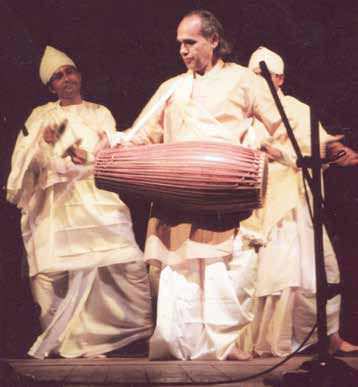Instruments Used:
Khol:
Khol is a percussion instrument (Abanabdha badya) mostly used in Northern and Eastern part of India for accompaniment with devotional music (Bhakti). It is similar to Mridang. Vaisnav Saint of Assam Mahapurush Shreemanta Shankardeva used khol for the first time during “Chihnayatra” (Drama, using pictures and without dialogue) From that time khol is considered as an integral part of the Ek Saran Naam Dharma culture and is used in Ankiya Bhaona (plays), Gayan-Bayan, Prasanga-kirtan and Borgeets (lyrical songs) in Assam. According to Assamese Neo-Vaishnavites, playing the khol is regarded as a holy activity and is also considered to be one of the most important traditional percussion instruments. It is also a key musical instrument that accompanies Sattriya dance performance.
There are so many histories about the origin of Khol. According to Natya Shastra, it is regarded as a resemblance to the ancient Gopuchha shape of drums. Previously it was made using clay, but slowly people started using wood instead of clay. The khol is a drum with a hollow earthen body, with drumheads at both the ends, right side far smaller than the left side. Both the drumheads are made from leather and to control the sound a patch is used on it. Khol is played using palm and fingers of both the hands.
In Sattriya culture, the Khol is an integral part of the Sattriya dance tradition. The dance form often depicts stories from Hindu mythology, especially those related to Lord Krishna. The rhythmic patterns produced by the Khol add a dynamic element to the dance performance, enhancing the overall aesthetic experience for the audience.The Khol is not only used in dance but also in the musical compositions associated with Sattriya culture. It plays a crucial role in creating the rhythmic foundation for various musical compositions, including Borgeet (devotional songs) and other traditional forms of Sattriya music.
In summary, the Khol in Sattriya culture serves as a vital musical instrument, contributing to the rhythmic and melodic aspects of Sattriya dance and music performances, enriching the cultural and artistic heritage of the region.
